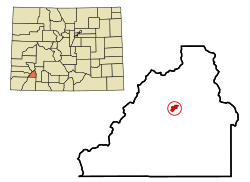Silverton, Colorado
| Town of Silverton, Colorado | |
|---|---|
| Town | |
 |
|
 Location in San Juan County and the state of Colorado |
|
| Coordinates: 37°48′45″N 107°39′47″W / 37.81250°N 107.66306°WCoordinates: 37°48′45″N 107°39′47″W / 37.81250°N 107.66306°W | |
| Country |
|
| State |
|
| County | San Juan County - seat |
| Established | 1874 |
| Incorporated | November 15, 1885 |
| Government | |
| • Type | Statutory Town |
| • Mayor | Christine Tookey |
| Area | |
| • Total | 0.8 sq mi (2.1 km2) |
| • Land | 0.8 sq mi (2.1 km2) |
| • Water | 0.0 sq mi (0.0 km2) |
| Elevation | 9,308 ft (2,837 m) |
| Population (2010) | |
| • Total | 638 |
| • Density | 656.0/sq mi (253.3/km2) |
| Time zone | Mountain (MST) (UTC-7) |
| • Summer (DST) | MDT (UTC-6) |
| ZIP code | 81433 (PO Box) |
| Area code(s) | 970 |
| FIPS code | 08-70580 |
| GNIS feature ID | 0204750 |
| Website | Town of Silverton |
|
Silverton Historic District
|
|

Grand Imperial Hotel, Silverton Historic District
|
|
| Location | Silverton, Colorado |
|---|---|
| Built | 1882 |
| Architect | Multiple |
| Architectural style | Late Victorian (original) Other (increase) |
| NRHP Reference # | 66000255 (original) and 97000247 (increase) |
| Significant dates | |
| Added to NRHP | October 15, 1966 (original) April 03, 1997 (boundary increase) |
| Designated NHLD | July 04, 1961 |
The town of Silverton is a Statutory Town that is the county seat of, and the only incorporated municipality in San Juan County, Colorado, United States. Silverton is a former silver mining camp, most or all of which is now included in a federally designated National Historic Landmark District, the Silverton Historic District. The town population was 531 at U.S. Census 2000.
Silverton is linked to Durango by the Durango and Silverton Narrow Gauge Railroad, a National Historic Landmark. Silverton no longer has active mining, but subsists by tourism, maintenance of US 550 (which links Montrose with Durango via Silverton), mine pollution remediation, and retirees. In 2002 an extreme ski mountain, Silverton Mountain, opened near the town.
According to the United States Census Bureau, the town has a total area of 0.8 square miles (2.1 km2), all of it land. Silverton is one of the highest towns in the United States, at 9,318 feet (2,836 m) above sea level. This is also where the book "The Christopher Killer" takes place.
Silverton has an alpine subarctic climate (Köppen climate classification Dfc) with very cold, snowy winters and cool to warm summers with adequate precipitation year round.
Charles Baker's group of prospectors found traces of placer gold in the San Juan Mountains in 1860 at Eureka, Colorado. Forced out by the Ute Tribe in 1861, who had been awarded the area in a US treaty. The prospectors returned in 1871, when lode gold was found in the Little Giant vein at Arrastre Gulch. The miners were allowed to stay after the Brunot Treaty of 13 Sept. 1873. In exchange for giving up 4 million acres, the Southern Ute Indian Reservation received $25,000 per year.
...
Wikipedia


